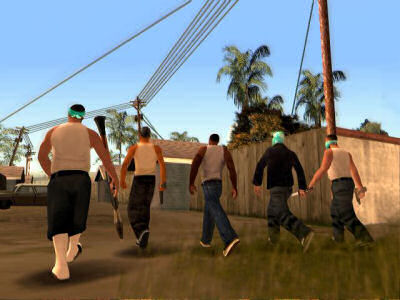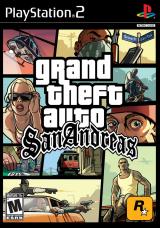The only way that Rockstar could have outdone the expansive, liberating experiences that its flagship series is known for is by exponentially increasing their scope and breadth. This is precisely what it's done in San Andreas. You're already familiar with the mathematics behind it: three cities, each roughly as large as the previous games' settings, comprising an entire state, as well as an expansive stretch of countryside connecting them. It's huge, and feels like it, and if you're susceptible to fits of fancy, rest assured that you could very easily lose yourself in these enormous, feature-rich environments. A compelling, convincingly delivered story will keep you interested all the way through, if you choose to pursue it, but like every GTA before it, San Andreas can be just as satisfying if you forego all the narrative stuff and just fool around in the environments.
But also like its predecessors, San Andreas' game mechanics can be frustratingly loose at times. I guess that's the cost of implementing so many open-ended systems into one product: no matter how cohesive the result can be, it's going to go haywire at times. Yes, you're going to get frustrated. Probably a lot. But if your experience is anything like mine, you're going to feel motivated to soldier on anyway.
San Andreas -- Rockstar's unapologetic, cartoonish caricature of 1990s California -- has successfully captured the tone of the American West Coast, and if you've lived there, you'll feel strangely at home. Each city has a tangible, distinctive sense of character, with features and activities unique to it. Los Santos, which is based on Los Angeles, is as sprawling and economically diverse as its real-life counterpart. Among other things, much of the gameplay set it in focuses on street-gang warfare, especially during the early phases of the game. You'll feel a genuine sense of safety in CJ's neighborhood of Ganton (e.g., Compton), and conversely, you'll be on edge when deep in Ballas territory.
San Fierro, the San Francisco analogue, features the same type of hilly terrain as the city that inspired it. The multitude of driving missions you'll engage in here use the topography to great effect, though the neighboring bay plays just as large a role. While its level of density isn't as convincing as the other two cities' in terms of faithfulness to its source material, certain neighborhoods do capture the feel of the real thing. In these cases, you really feel like you're there. San Fierro is home to some of the game's more interesting characters, and the missions they send you on are among the best-written. Expect some rather amusing celebrity appearances, some in a very literal sense.

Roll on your enemies.
The last city you get access to is Las Venturas, San Andreas' take on Las Vegas. Once you're here, the game's true scope reveals itself, as you gain access to various activities previously unavailable. When zooming through its glitzy streets, you get the feeling the city indeed never sleeps. You can while away the hours gambling at casinos, complete with a bunch of real-life games, or else casing and subsequently robbing them during missions. The desert that surrounds it provide just as significant a presence, and you'll spend many a mission wilting in its unrelenting heat.
The areas surrounding the three major cities are home to both rural stretches and a handful of fully-featured small towns. Contrary to what you would think, they're loaded with a surprising amount of stuff do, almost such that they could comprise a fourth "city" on their own. Far from just being scenery that you zip past when you don't have access to a faster mode of transport, you're going to want to explore them.





 Outstanding!
Outstanding!


